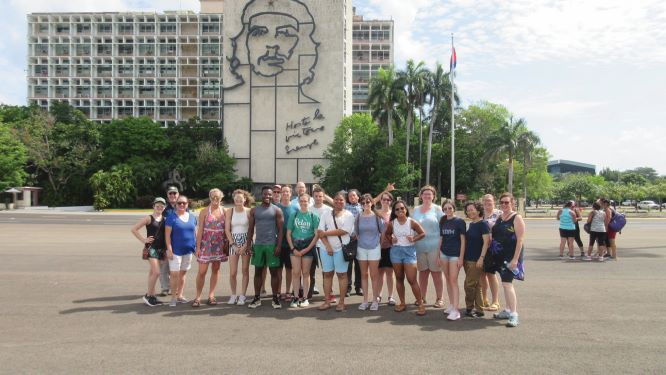Building bridges to other worlds: Developing collaborations and making friends in Cuba

Cuba is an amazing place — an island of historic cities, breathtaking landscapes and resilient people. It is a land of bright colors and frenetic rhythms, a center of great art, architecture, literature and music. A land of rum, coffee and tobacco.
Cuba has a rich history. It was the point of departure for the Spanish galleons that transported silver and gold across the Atlantic to Spain. Later it was the most important producer of sugar in the world. However, where Cuba continues to play a role beyond its size today is through its cultural heritage, as Cuban musicians, dancers and artists leave their mark around the world.
It was in this land that Dr. Lawrence Zettler and I began our adventure six years ago, when we traveled with the Cuban orchid scholar Ernesto Mujica. We went in search of the famed ghost orchid along Cuba’s remote Western coast, at the tip of the island, hundreds of miles from the nearest substantial city. During that adventure on an island so long off limits to most Americans, we knew that we had landed in a special place full of warm people with a vibrant culture, living in an environment worth researching and learning more about.
Since that first trip, I have returned several times every year, negotiating agreements with institutions in Western Cuba. Illinois College now has developed relationships with six different institutions in Western Cuba, which include the University of Pinar del Río, the Medical University of Pinar del Río, the Soroa Botanical Garden, the Guanahacabibes and Viñales National Parks, and the Documentation Center of Cuban Music Argeliers León.
In the past six years, Illinois College students and faculty have become part of the landscape of Western Cuba. During that time, a total of 48 Illinois College students have explored Cuba on four different BreakAways. A total of eight Illinois College students have traveled to Cuba on one of several research trips with Dr. Zettler, Dr. Bryan Arnold, and Cuban researchers to study bats and orchids in Guanahacabibes National Park and the Soroa Botanical Garden. And currently 11 Illinois College faculty members are actively collaborating with Cuban researchers and faculty on such topics as orchids, bats, autism, strategies for service learning, theater and gender, education, Cuban writers, second language learning, and music and music history.

While having a total of 56 students travel to Cuba is significant, we are working to provide even more opportunities for Illinois College students. Beginning in the spring of 2020, Illinois College students will be able to study at the University of Pinar del Rio or the Medical Sciences University of Pinar del Rio for an entire semester. In March of 2020, the Biology Department will offer a Cuban ecology course, which will include a weeklong field experience in Cuba. And plans are in the works for a summer program in Pinar del Rio in May of 2021, which will provide students with various disciplinary focuses, including healthcare, ecology, organic farming or education. Along with these experiences, individual Illinois College faculty members are planning research experiences in Cuba for students in their discipline.
In May, Illinois College celebrated its sixth year of building bridges, forging friendships and fostering cultural understanding between Cubans and Americans by sending to Cuba a group of faculty, students, alumni and trustees. While students took classes at the University of Pinar del Río and the Medical Sciences University of Pinar del Río, and faculty collaborated on research projects with University of Pinar del Río professors, I had the great pleasure of traveling with President Farley and a group of 21 alumni and trustees. Guided by a former University of Havana professor, we explored the realities of Cuba today, learning about how Cubans have adapted to their country’s political conflict with the United States and the resulting 60-year embargo.
Our guide gave the Illinois College alumni and trustees the greatest compliment that travelers could receive: he said that we were one of the most engaged groups he has had and that he appreciated our desire to understand Cuba and the Cuban people.
I am often asked “Why Cuba?” The answer to that question is multi-faceted. As a crossroads between North and South, East and West, Cuba is a melting pot of cultures and ethnicities. Cuba has integrated both women and Afro-Cubans into professional positions much better than most Latin American countries. And, most impressively, with very little money and a lack of access to important resources, Cuba has managed to provide free and universal access to healthcare and education. As we struggle with the cost of healthcare in the United States, Illinois College students benefit from engaging with Cuban medical students, who are trained to emphasize prevention. Cubans have had a difficult history, and what one admires is their tenacity, innovative spirit, and adaptability, along with their ability to maintain a sense of humor even during times of adversity.
Another question I often hear is “Why Pinar del Río in Western Cuba? Why not Havana?” Home to the precious ghost orchid, Western Cuba is a spectacular place to study ecology. And while big enough to have a university and a medical school, Pinar del Río is small enough for Illinois College students to feel comfortable. The institutions in Western Cuba have welcomed us warmly and have enthusiastically engaged in projects with Illinois College faculty and students. This gives Illinois College students and faculty the opportunity to collaborate on projects in a number of fields, including healthcare, agriculture, plant and animal conservation, music, and education. While our governments may bicker and foster conflict, Illinois College students and faculty are joining Cuban faculty and students to build bridges and work together to create a better future for all of us.


